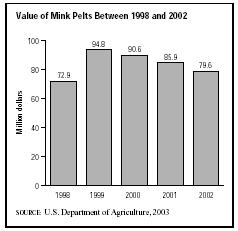SIC 0271
FUR-BEARING ANIMALS AND RABBITS
This classification covers establishments primarily engaged in the production of fur and fur-bearing animals and rabbits. These include chinchilla farms, fox farms, fur farms, mink farms, and rabbit farms.
NAICS Code(s)
112930 (Fur-Bearing Animal and Rabbit Production)
In 2003 a total of 318 establishments raised mink for pelts, down from 439 in 1998. Utah had the largest number of farms, with 80, followed by Wisconsin, with 69, and Minnesota, with 33. Of these, 20 establishments also raised fox. Value of the 2.60 million pelts produced that year was $79.6 million.
The majority of fur-bearing animal farms are small-scale operations that earn less than $250,000. In fact, no operation reports revenues of over $5 million. Most of the establishments in this industry employ fewer than five people.
In recent years, the fur-bearing animal raising industry has suffered the ill effects of fur's increasingly negative image. Many stores have closed down their fur departments under pressure from animal rights activists and in response to decreasing sales. As a result, sales of fur-bearing animals to the retail fur industry have steadily declined over the past few years. Although sales increased during the boom years of the 1980s, they plunged again as resistance became more pronounced. High-profile protest groups such as People for the Ethical Treatment of Animals (PETA) have proven adept at casting

the industry in an unflattering light. PETA has launched many rescue missions where members target fur farms and release the animals. In the 1990s the industry made a comeback, as fur came to be regarded as a versatile fabric, and the American economy improved. However, when the economy weakened in the early 2000s, fur sales once again dipped.
Mink has generally accounted for 50 to 60 percent of all fur production and sales. Only 601,000 females were bred in 2003, compared to 733,000 in 1998. Most pelts produced that year were of the standard color class, followed by mahogany, gunmetal, demibuff, and ranch wild. Despite increased production and sales, the fur industry faces an uncertain future.
Further Reading
U.S. Department of Agriculture. "Mink." National Agricultural Statistics Service. Washington, D.C., 15 July 2003. Available from http://usda.mannlib.cornell.edu/reports/nassr/other/zmi-bb/mink0703.txt .
Comment about this article, ask questions, or add new information about this topic: